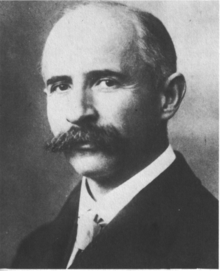Walter Kaufmann (physicist)
Walter Kaufmann | |
|---|---|
 | |
| Born | June 5, 1871 |
| Died | January 1, 1947 (aged 75) |
| Citizenship | German |
| Known for | Proof of the velocity dependence of mass |
Walter Kaufmann (June 5, 1871 – January 1, 1947) was a German physicist. He is best known for the first experimental proof of the velocity dependence of mass, which was an important contribution to the development of modern physics, including special relativity.
Life
Of
Measurements of velocity dependence of mass
Kaufmann's early work (1901–1903) confirmed for the first time the velocity dependence of the electromagnetic mass (later called relativistic mass) of the electron. However, the measurements were not accurate enough to differentiate between the Lorentz ether theory and that of Max Abraham.
At the end of 1905, Kaufmann carried out more accurate measurements. He was the first to discuss
Note, however, that this uncertainty concerned only the relativistic mass of the electron. Even in 1917, investigations of the fine structure of the hydrogen lines provided confirmation of the Lorentz-Einstein formula, contradicting that of Abraham.[8]
See also
References
- ^ Silvan S. Schweber, Nuclear Forces: The Making of the Physicist Hans Bethe, Harvard University Press (2012), p. 92
- ^ Hans Kangro (1977), "Kaufmann, Walter", Neue Deutsche Biographie (in German), vol. 11, Berlin: Duncker & Humblot, pp. 352–353
- ^ ISBN 978-0-201-04679-3
- Bibcode:1908AChPh..13..145R
- ^ Janssen, M.; Mecklenburg, M. (2007), "From classical to relativistic mechanics: Electromagnetic models of the electron", in V. F. Hendricks; et al. (eds.), Interactions: Mathematics, Physics and Philosophy, Dordrecht: Springer, pp. 65–134
- ^ Pauli, Wolfgang (1921), "Die Relativitätstheorie", Encyclopädie der Mathematischen Wissenschaften, 5 (2): 539–776
In English: Pauli, W. (1981) [1921]. Theory of Relativity. Vol. 165. )
Publications
- Kaufmann, W. (1901), "Die Entwicklung des Elektronenbegriffs", Physikalische Zeitschrift, 3 (1): 9–15
- —— (1901), "Die magnetische und elektrische Ablenkbarkeit der Bequerelstrahlen und die scheinbare Masse der Elektronen", Göttinger Nachrichten (2): 143–168
- —— (1902), "Über die elektromagnetische Masse des Elektrons", Göttinger Nachrichten (5): 291–296
- —— (1902), "Die elektromagnetische Masse des Elektrons", Physikalische Zeitschrift, 4 (1b): 54–56
- —— (1903), "Über die "Elektromagnetische Masse" der Elektronen", Göttinger Nachrichten (3): 90–103
- —— (1905), "Über die Konstitution des Elektrons", Sitzungsberichte der Königlich Preussischen Akademie der Wissenschaften (45): 949–956
- —— (1906), "Über die Konstitution des Elektrons", Annalen der Physik, 19 (3): 487–553,
External links
- The Kaufmann Experiments (Power point presentation)
- http://www-atm.jst.go.jp:8080/16030302_1.html (Japanese)
- Viaje medios de comunicación compras at itfisica.net at itfisica.net (Italian)
- Zeittafel (timetable about physics)
